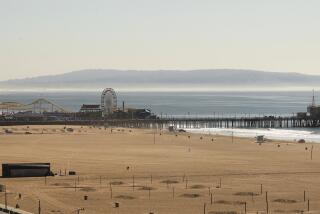Task Force on Cup Bullish on San Diego for Defense
- Share via
It may take as long as six months to select a place to hold the next America’s Cup races, Fred Frye, commodore of the San Diego Yacht Club, said Friday. The new estimate doubles the previous 90-day timetable made by yacht club and Sail America officials immediately after Dennis Conner and his Stars & Stripes crew won back the America’s Cup a little more than two weeks ago in Fremantle, Australia.
The first hint that the 90 days wouldn’t be enough came last week in New York, in comments made by Sail America President Malin Burnham, who said the schedule was likely to slip. Sail America is the fund-raising organization for Stars & Stripes.
Frye made his remark during a press conference called by the America’s Cup Task Force, the group created by Supervisor Brian Bilbray that has taken charge of putting together and presenting San Diego’s proposal to become the Cup defense site in 1990-91.
The task force had its first meeting Friday since returning from the Cup races in Australia. The session, held at the County Administration Building, was closed to the public and press. Afterward, Bilbray, Frye and Dan Larsen, chairman of the San Diego Unified Port District, met with reporters.
Bilbray and Larsen described a bullish effort to bring the cup races to San Diego, and the makeup of the task force would seem to indicate that the defense is San Diego’s to lose. Also on the task force is Gordon Luce, chairman and chief operating officer of Great American First Savings Bank, Admiral Bruce Boland, San Diego Councilman Bill Cleator, Alan Greenway, a developer representing the Australian American Chamber of Commerce; Lee Grissom, San Diego Chamber of Commerce president, and Richard Tuller, chairman of ConVis.
Acting as advisers to the group are Burnham and Sandy Purdon, executive director of Sail America. Burnham and Purdon aren’t formal members, Bilbray said, because of a potential conflict of interest.
Sail America, he explained, has the role of making recommendations to the yacht club people who will serve on the yet-to-be created site selection committee, a process Frye said may now take up to 45 days. It is that committee which will eventually hear the task force’s presentation.
“You’ve got a chance,” Bilbray said when asked what he tells cities interested in holding the defense. “But you’ve got to play catch-up . . . we’re way ahead.”
Cities which have expressed interest in the races, Bilbray said, are Newport, Honolulu, Long Beach, Santa Cruz, Monterey and Galveston.
“We are going to host the America’s Cup in San Diego County,” said a confident Bilbray, noting that the task force is well on its way toward identifying potential locations for use by the various racing syndicates, media and others involved in a Cup challenge. “The momentum is moving our way.”
Talking just as confidently was Larsen, who said the Port District is now considering a proposal by local shipyard owners offering use of their dock facilities. “We had a meeting with boatyard owners . . . and they told us they can do it themselves without building new facilities. That remains to be seen,” said Larsen, who added that the Port District will probably make an assessment of the capabilities of each boatyard.
There’s also a possibility that Quivira Basin, near the outlet of Mission Bay, could be used as a staging area for some of the racing boats, Larsen said.
The Port District is still probably a month away from drafting a detailed plan, he said.
Frye shied away from endorsing San Diego as strongly as Bilbray and Larsen, though he said nothing to indicate the city is not the front runner.
The San Diego Yacht Club’s “bottom line,” Frye said, is putting on a successful Cup defense. And although he wants to make a decision on a defense location as soon as possible, Frye said, it’s likely to take anywhere from four to six months.
San Diego’s relatively light winds and offshore kelp beds have been raised as potential obstacles to a successful cup regatta. But Frye labeled the kelp a “non-issue” because the race course would be routed away from the beds and said the question of wind was over-rated.
“Wind is power . . . but there’s a lot more to sailing than wind and hanging on for survival,” he said. In Fremantle, during the final races between Stars & Stripes and Kookaburra III, Frye said, there was a large variation in wind, from 9 to 10 knots to 20 to 29 knots. “Here, we’re more consistent, particularly in the mid-range” of 16 to 18 knots.
As for Conner’s view of where the races should be held--many in his crew favor Hawaii--Frye said that he spoke to the skipper a few days ago and Conner told him, “I want to defend the Cup. I’ll sail wherever the Cup is.”
Said Frye, “I don’t think he (Conner) has an oar in the water for any particular place . . . he knows what it’s like to sail in San Diego, he’s won world championships here.”
The biggest barrier facing the task force, according to Bilbray, is San Diego’s attitude. He said many people believe the area isn’t capable of pulling off an event such as the Cup races.
“We heard San Diego couldn’t hold a Super Bowl,” he said, noting that despite the naysayers, the city was able to attract the game scheduled for next January. Part of the problem is that the city as a whole needs to have more of a “can-do attitude,” Bilbray said.
More to Read
Sign up for The Wild
We’ll help you find the best places to hike, bike and run, as well as the perfect silent spots for meditation and yoga.
You may occasionally receive promotional content from the Los Angeles Times.






